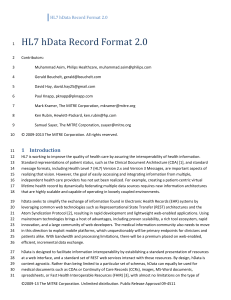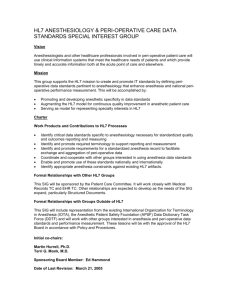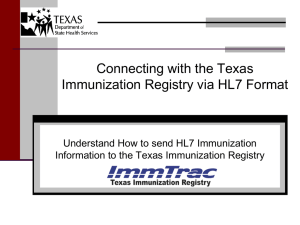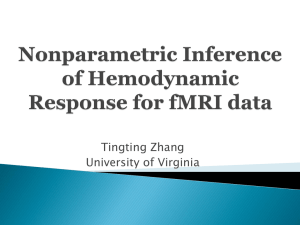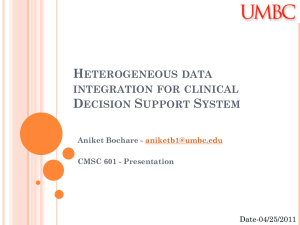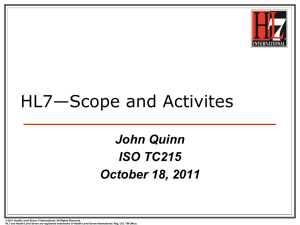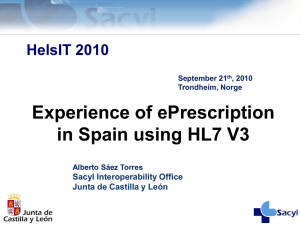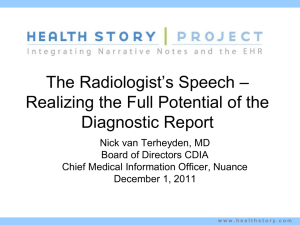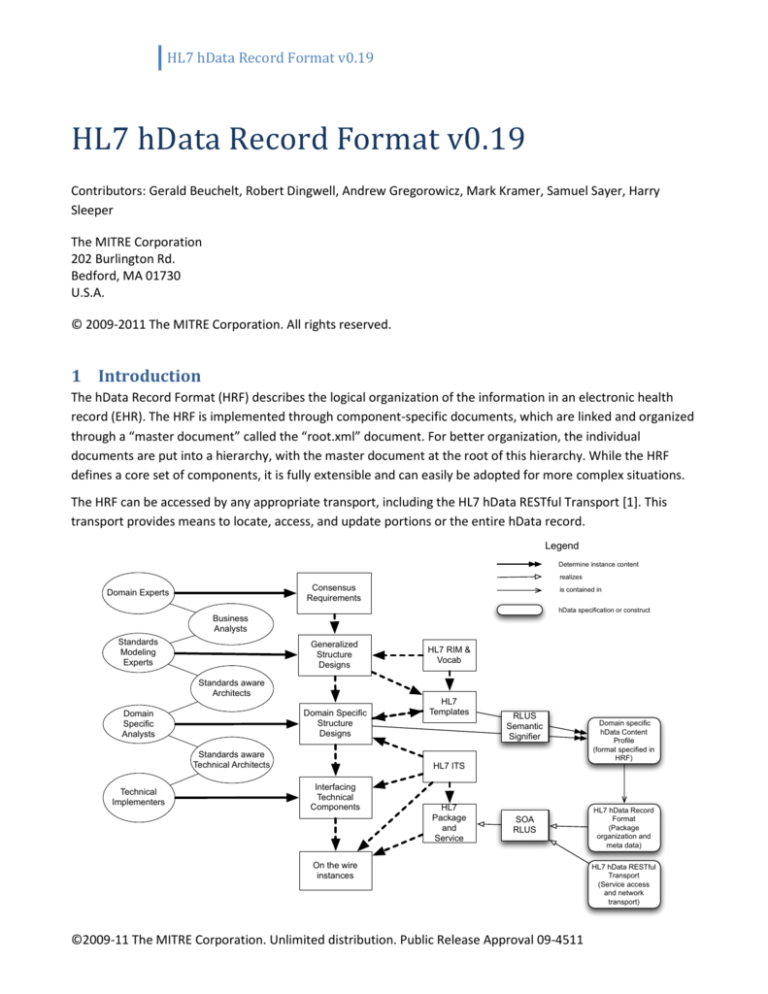
HL7 hData Record Format v0.19
HL7 hData Record Format v0.19
Contributors: Gerald Beuchelt, Robert Dingwell, Andrew Gregorowicz, Mark Kramer, Samuel Sayer, Harry
Sleeper
The MITRE Corporation
202 Burlington Rd.
Bedford, MA 01730
U.S.A.
© 2009-2011 The MITRE Corporation. All rights reserved.
1 Introduction
The hData Record Format (HRF) describes the logical organization of the information in an electronic health
record (EHR). The HRF is implemented through component-specific documents, which are linked and organized
through a “master document” called the “root.xml” document. For better organization, the individual
documents are put into a hierarchy, with the master document at the root of this hierarchy. While the HRF
defines a core set of components, it is fully extensible and can easily be adopted for more complex situations.
The HRF can be accessed by any appropriate transport, including the HL7 hData RESTful Transport [1]. This
transport provides means to locate, access, and update portions or the entire hData record.
Legend
Determine instance content
realizes
Consensus
Requirements
Domain Experts
is contained in
hData specification or construct
Business
Analysts
Standards
Modeling
Experts
Generalized
Structure
Designs
HL7 RIM &
Vocab
Standards aware
Architects
Domain Specific
Structure
Designs
Domain
Specific
Analysts
Standards aware
Technical Architects
Technical
Implementers
HL7
Templates
RLUS
Semantic
Signifier
Domain specific
hData Content
Profile
(format specified in
HRF)
HL7 ITS
Interfacing
Technical
Components
HL7
Package
and
Service
SOA
RLUS
On the wire
instances
©2009-11 The MITRE Corporation. Unlimited distribution. Public Release Approval 09-4511
HL7 hData Record
Format
(Package
organization and
meta data)
HL7 hData RESTful
Transport
(Service access
and network
transport)
HL7 hData Record Format v0.19
Given this characterization, the hData specifications can be seen as a realization of the SOA Retrieve, Locate,
Update, Service (RLUS) model. Domain Analysts should determine what content is appropriate to be included
in a given hData Content Profile, which is determined by a Localized Information Model (LIM). The HCP also
requires business justifications and behavioral modeling (where appropriate).
The information identified by the domain analysts must be rendered into “exchangeable goods” – this process
is governed by the applicable ITS (expand acronyms). This is fairly straightforward when using the standard
XML ITS, but future developments within the ITS WG may also allow simplified XML structures or JSON
encoded content for wire-level exchanges.
1.1 Namespaces
This document uses the following namespaces. This specification uses a number of namespace prefixes
throughout; they are listed in Table 1. Note that the choice of any namespace prefix is arbitrary and not
semantically significant.
Namespace
Namespace URI
Prefix
Description
hrf
http://projecthdata.org/hdata/schemas/2009/06/core
Namespace for elements in this
document
hcp
http://projecthdata.org/hdata/schemas/2010/04/hcp
Namespace for hData Content Profile
Description language
hrf-md
http://projecthdata.org/hdata/schemas/2009/11/metad
Namespace for metadata
ata
Xs
http://www.w3.org/2001/XMLSchema
XML Schema namespace
Ds
http://www.w3.org/2000/09/xmldsig#
Namespace for XML Digital Signature
Atom
http://www.w3.org/2005/Atom
Namespace for the Atom syndication
format
Rddl
http://www.rddl.org/
Namespace for RDDL
1.2 Glossary (Non-Normative)
HL7 hData Record Format (HRF) - this specification specifies an abstract hierarchical organization, packaging,
and metadata for individual documents (referred to as “Section Documents” within the HRF specification).
Section Documents can be of any type, either XML documents (such as CDA documents, H7v3 messages, or
simplified XML wire formats, etc.) or of other media types (such as e.g. MS Word documents or DICOM files).
Also contained in this specification is the format for specifying the content that goes into an hData record,
which is called the hData Content Profile (HCP) format.
©2009-11 The MITRE Corporation. Unlimited distribution. Public Release Approval 09-4511
HL7 hData Record Format v0.19
hData Record (HDR) - a single instance of the HRF.
HL7 hData Restful Transport - this specification defines how the abstract hierarchical organization defined
within the HRF specification is access and modified through a RESTful approach, using HTTP as the access
protocol. It creates a unique mapping to an URL structure, and defines how HTTP verbs such as GET, PUT,
DELETE, etc. affect the underlying information.
hData Content Profile (HCP) - a profile of the content of an HDR. The HRF specification contains the definition
of the HCP format.
RLUS --- fill in!!
1.3 Notational Conventions
The keywords "MUST", "MUST NOT", "REQUIRED", "SHALL", "SHALL NOT", "SHOULD", "SHOULD NOT",
"RECOMMENDED", "MAY", and "OPTIONAL" in this document are to be interpreted as described in RFC 2119.
When describing concrete XML schemas, this specification uses the following notation: each member of an
element's [children] or [attributes] property is described using an XPath notation (e.g.,
/x:MyHeader/x:SomeProperty/@value1).
Note also that only the W3C XML schemas linked in section 4 at the end of this document are normative – any
schema fragment or other schema description within the main body of this document are informational only.
©2009-11 The MITRE Corporation. Unlimited distribution. Public Release Approval 09-4511
HL7 hData Record Format v0.19
2 Hierarchical Organization
The basic approach of the hData Record Format is to represent the medical data through linked documents,
which are organized through an abstract hierarchy. The hData RESTful API specification maps this abstract
hierarchy to a concrete implementation, such as a web resource hierarchy.
hData Record
root.xml
- Manifest
document
describing the
content of the
record
Section
- Container for Section Documents
and child Sections
- Provides metatdata per
document through an Atom feed
Section Document
Section
(actualDocument
medical data
Section
(actualDocument
medical data
document - XML or
- actual
medical -data
document
XML or
arbitrary Internet
media
document
arbitrary Internet
type) media
- XML or arbitrary
type) Internet
media type
Section
Document
Document
Section
Document
Section
Document
Document
Section
Document
©2009-11 The MITRE Corporation. Unlimited distribution. Public Release Approval 09-4511
HL7 hData Record Format v0.19
In order to be able to accommodate more complex situations, HRF was designed with a number of extension
points that allow the definition and insertion of new components.
2.1 Overall Structure
At the root of the hierarchy is the root document (RD). The content is contained in component specific
sections, some of which are REQUIRED. The component specific sections are the primary extension points
within the hierarchy. Implementers can either extend existing component sections or define new sections.
Such newly created sections MUST be registered in the RD to be accessible.
Each section corresponds to a single set of documents. Documents are grouped into sections by type. For
example, a section may contain laboratory result documents.
2.2 Root Document
The root document is at the root of the hierarchy. It contains the following elements (REQUIRED if not marked
otherwise):
/hrf:id - This element uniquely identifies the document, e.g. through a textual representation of a
UUID. It is RECOMMENDED to not use absolute URIs, but only fragments that may be used within a URI.
/hrf:version - The version of the hData Record Format used within this document. It is an integer that
corresponds to the version number of the hData Record Specification that is implemented. The version
number for records complying with this version of the specification is 1.
/hrf:created - Creation date of the document, using the W3C XML Schema Date data type. This data
SHOULD be significant to at least the second.
/hrf:lastModified - Last modification of the document, using the W3C XML Schema Date data type. This
data SHOULD be significant to at least the second.
/hrf:extensions - Node containing a list of extensions (list of hrf:extension elements). Any extension to
this specification MUST register itself in this section. The list of children of this element represents the
list of HL7 RLUS semantic signifiers, as required by [5], section 5.2.1.
/hrf:extensions/hrf:extension (OPTIONAL) - This text element contains a unique identifier for the
extension. It is RECOMMENDED to use an URL. For elements of content type “application/xml”, it is
RECOMMENDED that the text element contains an URL that provides a RDDL document [3] that
describes the format of instances of XML document of this extension type by including a
<rddl:resource> element with the xlink:role attribute set to the schema definition. For other content
types, it is RECOMMENDED that the RDDL document resolves to documentation of the Section
Document format, such as a PDF or HTML description. To allow sections that store no Section
Documents, a root.xml MUST define an extension node of value “urn:empty”.
/hrf:extensions/hrf:extension/@contentType (OPTIONAL) - This attribute contains the content type of
all documents in a section that registers with this extension. If the attribute is not present, the
documents in the section MUST be of content type “application/xml”.
/hrf:extensions/hrf:extension/@extensionId – This attribute contains a local identifier for the
extension. It MUST be unique within the root document.
/hrf:sections - This node contains references to all component-specific sections (hrf:section)
/hrf:sections/hrf:section (OPTIONAL) - A hrf:section describes an abstract collection of data elements
within an hData record.
©2009-11 The MITRE Corporation. Unlimited distribution. Public Release Approval 09-4511
HL7 hData Record Format v0.19
/hrf:sections/hrf:section/@path - This text attribute is a path segment, used to construct the full path
to the section from the root of the HDR document. Valid characters are [a-z][A-Z][0-9] and [.]. The full
path to a section is obtained by starting with a forward slash (“/”), and concatenating the path
segments, separated by forward slashes. It is RECOMMENDED that organizations creating hData
Content Profile use their domain name in the first path segment (such as e.g. org.hl7.sample) to avoid
namespace collisions in the full path name.
/htf:sections/hrf:section/@extensionId - This identifier MUST be equal to the identifier of any of the
registered extension elements, as identified by the id attribute of the <extension> element. It describes
the default contentType for documents contained in this section. Note that the metadata for each
individual document MAY override the default contentType.
/hrf:sections/hrf:section/@name (OPTIONAL) - Used for a human-friendly name to this section.
/hrf:sections/hrf:section/@requirement (OPTIONAL) – this attribute indicates if a given section is
required or optional. Valid values are “required” or “optional”. If this attribute is not present, the
section is “required”. NOTE: This attribute is ignored in the root document for HDRs. It is only used for
the hData Content Profile Description Language (see section 3).
The root document schema MAY be extended to support additional features such as a mechanism to record
versions of the data contained in the document.
2.3 Extensions
Extensions define the default type of Section Documents that MAY appear in a Section. Extensions MUST be
identified by a globally unique identifier. It is RECOMMENDED that this unique identifier be a URL pointing to a
RDDL document. Section Documents MAY override the default type in their metadata, but only with Extensions
that are registered in the RD.
The RDDL document will assist in the creation, consumption or validation of Section Documents. It is
RECOMMENDED that Extensions using XML-based Section Documents include a <rddl:resource> element with
the xlink:role attribute set to “http://www.w3.org/2001/XMLSchema”. For Extensions using other content
types, it is RECOMMENDED that the RDDL document includes a description of the acceptable content in
Section Documents.
From an HL7 RLUS perspective, each Extension is a semantic signifier, and the root.xml document defines a
default semantic signifier for each Section.
2.4 Sections
Sections within an hData record form an abstract hierarchy, similar to the file folder structure commonly used
in hierarchical file systems. Sections can contain either Section Documents or other Sections. Sections are
identified by their path. The path to a Section is constructed by starting with a forward slash (“/”) and
appending all section path names from the root of the HDR to the Section. Section Documents contained in
Sections comply with the contentType of an Extension registered in the RD. An Extension MUST be listed in
/hrf:extensions for it to be used by a Section. Sections MAY use the same semantics for confidentiality, access
control, and consent as described in the metadata for Section Document in 2.6. Sections MAY be empty.
©2009-11 The MITRE Corporation. Unlimited distribution. Public Release Approval 09-4511
HL7 hData Record Format v0.19
2.5 Section Documents
At each section a collection of documents can be obtained. Within each Section, the documents MUST conform
to the type defined by the Extension unless declared otherwise by the Section Document’s metadata. Section
documents can be of any media type, including binary media types.
2.6 Section Document Metadata
Each section contains a collection of metadata artifacts that are associated with each Section Document. The
container format for this metadata is Atom, described in RFC 5023. Each Section Document MUST have a
corresponding </atom:feed/atom:entry> element. If the Section Document type is different from the type
defined in the Section’s Extension, it MUST indicate its type in the /atom:feed/atom:entry/atom:link/@type
attribute. Each </atom:feed/atom:entry> must contain an <atom:link> element where the href attribute refers
to the Section Document. Additional metadata is contained in the </atom:feed/atom:entry/atom:content>
element, in an XML fragment starting with <hrf-md:DocumentMetaData>.
2.6.1 Section Feed Element Requirements
The following Atom feed level elements are RECOMMENDED:
<atom:title> - This element SHOULD provide the full path from the root of the hData record to the
Section, beginning with a “/” character, and separating each Section path segment with “/” characters.
<atom:updated> - This element SHOULD provide the time when the Section or any of its child elements
were last modified. Modifications could be new, updated, or deleted Section Documents or Sections, or
changes to the metadata.
<atom:link rel=”self” type=”application/atom+xml”> This OPTIONAL element applies to transport that
identify Sections by web resource identifiers (see [Atom 1.0], section 4.2.7). It has an href attribute
with a globally unique URI that identifies the Section.
2.6.2 <atom:entry> Element Requirements
For each child of a section (either Section Document or Section) the Atom feed of the parent section provides
one <atom:entry> node. The following list of child nodes defines how they MUST be populated:
<atom:id> - This element contains a name for the document that is unique over the parent Section. For
child Sections this name is the path segment for the child Section, as defined in the root.xml document.
This element MUST be identical to the DocumentId element in the document metadata (see section
2.6.3).
<atom:link>This OPTIONAL element applies to transport that identify Section Documents and Sections
by web resource identifiers (see [Atom 1.0], section 4.2.7). It has an href attribute with a globally
unique URI that identifies the Section or Section Document. For Sections, it MUST contain a type
attribute with value “application/atom+xml”. For Section Documents it SHOULD contain a type
attribute that is identical to the media type of the referenced Section Document. If the media type is
different from the Section default media type (as identified by the root.xml extension node), the type
attribute is REQUIRED.
<atom:updated> - For Section Documents, this element contains a W3C Date that is identical to the
Section Document’s metadata CreatedDateTime or the newest ModifiedDateTime (see section 2.6.3)
time.
©2009-11 The MITRE Corporation. Unlimited distribution. Public Release Approval 09-4511
HL7 hData Record Format v0.19
2.6.3
Section Document Metadata Definition
/hrf-md:DocumentMetaData - DocumentMetaData is the top-level element for the hData metadata
specification.
/hrf-md:DocumentMetaData/hrf-md:PedigreeInfo (OPTIONAL) - This optional node holds the pedigree
information for the Section Document. It is of type <hrf-md:PedigreeInfo>
/hrf-md:DocumentMetaData/hrf-md:DocumentId - This required text element holds an identifier for
the Section Document. It MUST be unique over any given Section.
/hrf-md:DocumentMetaData/hrf-md:LinkedDocuments (OPTIONAL) - This optional node holds a list of
URI links to documents that are related to this Section Document. Use depends on the semantics of the
Section Document Type. It can have <hrf-md:LinkInfo> typed child elements.
/hrf-md:DocumentMetaData/hrf-md:RecordDate - This required node holds the information about
Document creation and modification.
/hrf-md:DocumentMetaData/hrf-md:RecordDate/hrf-md:CreatedDateTime - This required element of
type <xs:dateTime> contains the dateTime of creation of this document. If this document is not
derived (see PedigreeInfo), this is the time of the creation of the original. If this document is derived
from another origin, this element contains the date of derivation.
/hrf-md:DocumentMetaData/hrf-md:RecordDate/hrf-md:Modified (OPTIONAL) - This optional node is
first created when the document is changed for the first time. It contains a collection of modification
dates with optional pedigree information of the modifier.
/hrf-md:DocumentMetaData/hrf-md:RecordDate/hrf-md:Modified/hrf-md:ModfiedDateTime - This
required element of type <xs:dateTime> records a dateTime when the document was modified.
/hrf-md:DocumentMetaData/hrf-md:RecordDate/hrf-md:Modified/hrf-md:PedigreeInfo (OPTIONAL) –
This optional node of type <hrf-md:PedigreeInfo> contains the pedigree information of the modifier.
/hrf-md:DocumentMetaData/hrf-md:Confidentiality (OPTIONAL) – This element contains controls for
confidentiality - details are out of scope for this specification and MAY be specified by an hData Access
Control specification.
/hrf-md:DocumentMetaData/hrf-md:AccessControl (OPTIONAL) - This element contains controls for
access control - details are out of scope for this specification and MAY be specified by an hData Access
Control specification.
/hrf-md:DocumentMetaData/hrf-md:Consent (OPTIONAL) - This element contains controls for consent
- details are out of scope for this specification and MAY be specified by an hData Access Control
specification. It should be noted that consent MAY be PII, and in those cases MUST be protected from
general unlimited disclosure.
There are two more types that are being used in <hrf-md:DocumentMetaData>: <hrf-md:PedigreeInfo> and
<hrf-md:LinkInfo>. This is the schema for <hrf-md:PedigreeInfo>
/hrf-md:PedigreeInfo - This node contains the document pedigree information.
/hrf-md:PedigreeInfo/hrf-md:XmlSignature (OPTIONAL) - This optional node contains the signature
information on the document or this metadata. This signature MUST conform to the W3C XML
Signature Syntax and Processing (Second Edition) [2] specification.
/hrf-md:PedigreeInfo/hrf-md:XmlSignature/@documentMethod - This optional attribute indicates
what method was used to transform binary Section Document media types into XML files for signature.
©2009-11 The MITRE Corporation. Unlimited distribution. Public Release Approval 09-4511
HL7 hData Record Format v0.19
Currently the only permitted methods are xml, sha256 and base64. xml is the default XML signature
over XML documents. base64 encodes a data stream into an XML document. The root contains the
BASE64 encoded data. sha256 calculates a hash over the binary stream and signs this hash.
/hrf-md:PedigreeInfo/hrf-md:XmlSignature/ds:Signature (0..unbounded) - A collection of XML
Signatures. This Signature MUST contain:
1. A valid Reference to either the metadata or the Section Document
2. The ds:KeyInfo for the signer (optional with DSig - required here)
/hrf-md:PedigreeInfo/hrf-md:Source (OPTIONAL) - This node indicates the source of this data.
/hrf-md:PedigreeInfo/hrf-md:Source/@derived - If the data is derived (i.e. copied or compiled from
other sources) this attribute of type <xs:boolean> MUST be set to true.
/hrf-md:PedigreeInfo/hrf-md:Source/hrf-md:PedigreeInfo (0..unbounded) – This element contains the
<hrf-md:PedigreeInfo> of the all source from which this document was derived.
/hrf-md:PedigreeInfo/hrf-md:Source/hrf-md:Document (0..unbounded) – This element of type <hrfmd:LinkInfo> contains links to all documents from which this document was derived.
/hrf-md:PedigreeInfo/hrf-md:Author (0..unbounded) – This element contains the names or identifiers
of all author(s).
/hrf-md:PedigreeInfo/hrf-md:Organization (0..unbound) - This element identified the organization(s)
at which this document was created.
This is the schema for <hrf-md:LinkInfo>:
/hrf-md:LinkInfo – This node contains the link information
/hrf-md:LinkInfo/hrf-md:Target –This required element of type <xs:anyURI> contains the absolute link
to the referenced Section Document.
/hrf-md:LinkInfo/hrf-md:Target/@extension (OPTIONAL) – <xs:anyURI> Semantic signifier for content
at target.
/hrf-md:LinkInfo/##any (OPTIONAL) – extension point.
2.6.4 Metadata Processing Instructions
The metadata for a Section Document is only valid for the system that currently hosts the Section Document. If
an HDR is copied in portions or in its entirety, the system to which it is copied (referred to below as “new
system”) MUST recompute the metadata according to the following rules:
1. The DocumentId MUST be kept unchanged.
2. The RecordData MUST be updated by adding a new RecordDate/Modified element. This element MUST
contain the DateTime of the operation. The RecordDate/Modified does not need to contain a
PedigreeInfo field for the new system, including a KeyInfo, if the document was not modified. The
Source/@derived attribute MUST be set to true, and a LinkInfo to the original Section Document
location SHOULD be provided.
3. Confidentialty, AccessControl, and Consent SHOULD be copied verbatim.
©2009-11 The MITRE Corporation. Unlimited distribution. Public Release Approval 09-4511
HL7 hData Record Format v0.19
3 hData Content Profiles
This specification does not specify which sections are required for an hData Record. This is done in separate
hData Content Profiles (HCP) which are specified through a HCP documentation package. An hData Content
Profile prescribes the required and optional content a record must provide, and allocates the place for the
Section Documents within the hierarchical structure. Note that a single hData record can be compliant with
multiple HCPs.
3.1 Relationship to HL7 RLUS
Similar to RLUS [4], the definition of the payloads contained in an HDR is beyond the scope of the HL7 hData
specification. The HCP definition document (see section 3.3) or the metadata for each Document contains the
RLUS semantic signifiers ([4], section 9.1) for the SectionDocument resource in the form or a URI. As such, any
HL7 Version 3 compliant HCP will need to be accompanied by a Localized Information Model (LIM) that
formally describes the semantic signifiers. As such, an HCP constitutes Semantic Profile in the sense of [5],
Section 6.1.
3.2 HCP Documentation Package
The HCP documentation package is composed of the following documents:
1. HCP definition document (see section 3.3) – This document is REQUIRED
2. Semantics of the Record – this document is REQUIRED
a. Scope and Lifecycle of the record and its sections, and section documents
b. Meaning of inbound and outbound redirects
c. Semantics of the sectional structure
3. If the HCP contains XML documents, a complete set of all applicable normative XML schemas
referenced in the HCP definition document MUST be shipped as part of the package; referencing
schemas is not allowed. For XML documents that cannot be described by normative schemas, a
specification for describing the syntax of these documents MUST be provided by reference or shipped
as part of the HCP documentation package. For non-XML based content, references to a authoritative
syntax definition MUST be provided.
4. Sample instance – A sample instance of an hData record that complies with the HCP is strongly
RECOMMENDED. The sample instance SHOULD be provided through serialized SectionDocuments that
are stored in a hierarchical file system corresponding to the Section layout described in the HCP
definition document. Sections correspond to file system directories and a XML document containing
the Atom feed for the section. To simplify transmission these documents MAY be stored in a file
archive supporting hierarchical file storage.
5. Transforms to XML ITS/CDA – If the HCP uses a simplified wire format, it SHOULD provide XML
transforms for converting the simplified wire format into HL7 v3 XML ITS or CDA R2 or future versions,
respectively, if the exchanged data can be mapped to HL7 data types. The transforms are REQUIRED if
they are possible.
©2009-11 The MITRE Corporation. Unlimited distribution. Public Release Approval 09-4511
HL7 hData Record Format v0.19
6. Master documentation – This REQUIRED text document MUST include the purpose, applicable business
requirements, and a basic justification for the HCP need. It is REQUIRED, but its scope depends on the
original intent of the HCP.
7. Behavioral model and business rules – If the domain for the HCP must adhere to a behavioral model or
a set of business rules, these MUST be documented. This documentation SHOULD include applicable
UML diagrams or similar documentation. This document is REQUIRED if a behavioral model or business
rules exist.
8. Use cases – The applicable use cases SHOULD be captured in a suitable document.
9. Testing and conformance documents – If there are any additional testing or conformance
requirements, these SHOULD be documented here.
10. Change log – This REQUIRED document must contain the following information for the current and
every prior version of the HCP:
a. Date of change
b. Name of editors and/or organization
c. Version-aware identification URL (see 11.a)
d. Major changes
e. Other comments
11. Other Metadata – This REQUIRED metadata can be documented in a single HTML document.
a. URL for identification – This URL MUST be version aware, i.e. it MUST be different for differing
versions of the HCP. This can be achieved by including the change year and month in the URL.
The URL SHOULD resolve to a publicly accessible HTML resource that contains links to all
documents needed for the HCP.
b. Name, summary, initial creation date
3.3 hData Content Profile Definition Document
To describe hData Content Profiles, the following schema is used for the HCP definition file:
/hcp:hcp – the root element for a HCP definition file.
/hcp:hcp/@name – a simple display name
/hrf:hcp/@id – a URI identifying the hData Content Profile. It is RECOMMENDED to use a URL that can
be resolved into the HCP definition document.
/hrf:hcp/hrf:extensions – this element describes the extensions used in this HCP. It uses the same
syntax as in the root document as described in section 2.2.
/hrf:hcp/hrf:sections – this element describes the sections that are to be included in a hData record
that claims conformance to the HCP. It uses the same syntax as in the root document as described in
section 2.2. NOTE: the requirements attribute is being used in the HCP, as described above.
©2009-11 The MITRE Corporation. Unlimited distribution. Public Release Approval 09-4511
HL7 hData Record Format v0.19
4 Schemas
4.1 Root Document
This section contains the schema for the root document (see Section 2.2). All instances of root documents
MUST validate against this schema definition.
<?xml version="1.0" encoding="UTF-8"?>
<!-- Copyright 2009 The MITRE Corporation
Licensed under the Apache License, Version 2.0 (the "License");
you may not use this file except in compliance with the License.
You may obtain a copy of the License at
http://www.apache.org/licenses/LICENSE-2.0
Unless required by applicable law or agreed to in writing, software
distributed under the License is distributed on an "AS IS" BASIS,
WITHOUT WARRANTIES OR CONDITIONS OF ANY KIND, either express or
implied.
See the License for the specific language governing permissions and
limitations under the License. -->
<xs:schema xmlns:xs="http://www.w3.org/2001/XMLSchema"
xmlns:core="http://projecthdata.org/hdata/schemas/2009/06/core"
elementFormDefault="qualified"
targetNamespace="http://projecthdata.org/hdata/schemas/2009/06/core">
<xs:element name="root">
<xs:complexType>
<xs:all>
<xs:element ref="core:id"/>
<xs:element ref="core:version"/>
<xs:element ref="core:created"/>
<xs:element ref="core:lastModified"/>
<xs:element ref="core:extensions"/>
<xs:element ref="core:sections"/>
</xs:all>
</xs:complexType>
</xs:element>
<xs:element name="id" type="xs:string"/>
<xs:element name="version" type="xs:string"/>
<xs:element name="created" type="xs:date"/>
<xs:element name="lastModified" type="xs:date"/>
<xs:element name="extensions">
<xs:complexType>
<xs:sequence>
<xs:element minOccurs="0" maxOccurs="unbounded"
ref="core:extension"/>
</xs:sequence>
©2009-11 The MITRE Corporation. Unlimited distribution. Public Release Approval 09-4511
HL7 hData Record Format v0.19
</xs:complexType>
</xs:element>
<xs:element name="extension">
<xs:complexType mixed="true">
<xs:attributeGroup ref="core:extension"/>
</xs:complexType>
</xs:element>
<xs:element name="sections">
<xs:complexType>
<xs:sequence>
<xs:element minOccurs="0" maxOccurs="unbounded"
ref="core:section"/>
</xs:sequence>
</xs:complexType>
</xs:element>
<xs:attributeGroup name="extension">
<xs:attribute name="contentType" type="xs:string"
use="optional"/>
<xs:attribute name="extensionId" type="xs:string"
use="required"/>
</xs:attributeGroup>
<xs:element name="section">
<xs:complexType>
<xs:sequence>
<xs:element minOccurs="0" maxOccurs="unbounded"
ref="core:section"/>
</xs:sequence>
<xs:attribute name="path" use="required"/>
<xs:attribute name="name" use="optional"/>
<xs:attribute name="extensionId" use="required"/>
<xs:attribute name="requirement" use="optional">
<xs:simpleType>
<xs:restriction base="xs:token">
<xs:enumeration value="mandatory"/>
<xs:enumeration value="optional"/>
</xs:restriction>
</xs:simpleType>
</xs:attribute>
</xs:complexType>
</xs:element>
</xs:schema>
©2009-11 The MITRE Corporation. Unlimited distribution. Public Release Approval 09-4511
HL7 hData Record Format v0.19
4.2 hData Content Profile Definition
This section contains the schema for the hData Content Profile defintion (see section 3). All instances of HCP
definition documents MUST validate against this schema definition.
<?xml version="1.0" encoding="UTF-8"?>
<!-- Copyright 2010 The MITRE Corporation
Licensed under the Apache License, Version 2.0 (the "License"); you
may not use this file except in compliance with the License. You may
obtain a copy of the License at
http://www.apache.org/licenses/LICENSE-2.0
Unless required by applicable law or agreed to in writing, software
distributed under the License is distributed on an "AS IS" BASIS,
WITHOUT WARRANTIES OR CONDITIONS OF ANY KIND, either express or
implied.
See the License for the specific language governing permissions and
limitations under the License. -->
<xs:schema xmlns:xs="http://www.w3.org/2001/XMLSchema"
xmlns:hcp="http://projecthdata.org/hdata/schemas/2010/04/hcp"
xmlns:core="http://projecthdata.org/hdata/schemas/2009/06/core"
elementFormDefault="qualified"
targetNamespace="http://projecthdata.org/hdata/schemas/2010/04/hcp">
<xs:import
namespace="http://projecthdata.org/hdata/schemas/2009/06/core"
schemaLocation="http://github.com/projecthdata/hData/raw/master/schem
as/2009/06/root.xsd"/>
<xs:element name="hcp">
<xs:complexType>
<xs:all>
<xs:element ref="core:extensions"/>
<xs:element ref="core:sections"/>
</xs:all>
<xs:attribute name="name" use="required" type="xs:string"/>
<xs:attribute name="id" use="required" type="xs:anyURI"/>
</xs:complexType>
</xs:element>
</xs:schema>
4.3 Section Document Metadata
This section contains the schema for the Section Document metadata (see Section 2.6). All instances of
metadata documents MUST validate against this schema definition.
<?xml version="1.0" encoding="UTF-8"?>
©2009-11 The MITRE Corporation. Unlimited distribution. Public Release Approval 09-4511
HL7 hData Record Format v0.19
<!-- Copyright 2009 The MITRE Corporation
Licensed under the Apache License, Version 2.0 (the "License");
you may not use this file except in compliance with the License.
You may obtain a copy of the License at
http://www.apache.org/licenses/LICENSE-2.0
Unless required by applicable law or agreed to in writing,
software
distributed under the License is distributed on an "AS IS" BASIS,
WITHOUT WARRANTIES OR CONDITIONS OF ANY KIND, either express or
implied.
See the License for the specific language governing permissions
and
limitations under the License. -->
<xs:schema xmlns:xs="http://www.w3.org/2001/XMLSchema" xmlns:hdmd="http://projecthdata.org/hdata/schemas/2009/11/metadata"
xmlns:ds="http://www.w3.org/2000/09/xmldsig#"
elementFormDefault="qualified"
targetNamespace="http://projecthdata.org/hdata/schemas/2009/11/metada
ta">
<xs:import namespace="http://www.w3.org/2000/09/xmldsig#"
schemaLocation="http://www.w3.org/TR/2008/REC-xmldsig-core20080610/xmldsig-core-schema.xsd"/>
<xs:element name="DocumentMetaData">
<xs:annotation>
<xs:documentation>
DocumentMetaData is the top-level element for the
hData meta data specification. It is
embedded with every Atom 1.0 Content node.
</xs:documentation>
</xs:annotation>
<xs:complexType>
<xs:sequence>
<xs:element minOccurs="0" name="PedigreeInfo" type="hdmd:PedigreeInfo">
<xs:annotation>
<xs:documentation>
This optional node holds the pedigree
information for the Section Document.
</xs:documentation>
</xs:annotation>
</xs:element>
<xs:element name="DocumentId" type="xs:string">
<xs:annotation>
©2009-11 The MITRE Corporation. Unlimited distribution. Public Release Approval 09-4511
HL7 hData Record Format v0.19
<xs:documentation>
This required element holds an identifier
for the Section Document. It MUST be unique over any given
Section feed.
</xs:documentation>
</xs:annotation>
</xs:element>
<xs:element name="Title" type="xs:string">
<xs:annotation>
<xs:documentation>
This required element holds the title of
the Section Document.
</xs:documentation>
</xs:annotation>
</xs:element>
<xs:element minOccurs="0" name="LinkedDocuments">
<xs:annotation>
<xs:documentation>
This optional node holds a list of URI
links to documents that are related to this
Section Document. Use depends on the
semantics of the Section Document Type.
</xs:documentation>
</xs:annotation>
<xs:complexType>
<xs:sequence>
<xs:element maxOccurs="unbounded" name="Link" type="hdmd:LinkInfo"/>
</xs:sequence>
</xs:complexType>
</xs:element>
<xs:element name="RecordDate">
<xs:annotation>
<xs:documentation>
This required node holds the information
about Document creation and modification.
</xs:documentation>
</xs:annotation>
<xs:complexType>
<xs:sequence>
<xs:element name="CreatedDateTime" type="xs:dateTime">
<xs:annotation>
<xs:documentation>
This required element
contains the dateTime of creation of this documment. If this document
is not derived (see PedigreeInfo), this is the time of the creation
©2009-11 The MITRE Corporation. Unlimited distribution. Public Release Approval 09-4511
HL7 hData Record Format v0.19
of the original. If this document is derived from another origin,
this element contains the date of derivation.
</xs:documentation>
</xs:annotation>
</xs:element>
<xs:element minOccurs="0" name="Modified">
<xs:annotation>
<xs:documentation>
This optional node is first
created when the document is changed for the first time. It contains
a collection of modification dates with optional pedigree information
of the modifier.
</xs:documentation>
</xs:annotation>
<xs:complexType>
<xs:sequence minOccurs="1" maxOccurs="unbounded">
<xs:element name="ModifiedDateTime"
type="xs:dateTime">
<xs:annotation>
<xs:documentation>
This required
element record a dateTime when the document was modified.
</xs:documentation>
</xs:annotation>
</xs:element>
<xs:element minOccurs="0" name="PedigreeInfo"
type="hd-md:PedigreeInfo">
<xs:annotation>
<xs:documentation>
This optional
node contains the pedigree information of the modifier.
</xs:documentation>
</xs:annotation>
</xs:element>
</xs:sequence>
</xs:complexType>
</xs:element>
</xs:sequence>
</xs:complexType>
</xs:element>
<xs:element minOccurs="0" name="Confidentiality"
type="xs:string">
<xs:annotation>
<xs:documentation>
This element contains controls for
confidentiality - details are TBD.
</xs:documentation>
</xs:annotation>
©2009-11 The MITRE Corporation. Unlimited distribution. Public Release Approval 09-4511
HL7 hData Record Format v0.19
</xs:element>
<xs:element minOccurs="0" name="AccessControl">
<xs:annotation>
<xs:documentation>
This element contains controls for access
control - details are TBD.
</xs:documentation>
</xs:annotation>
</xs:element>
<xs:element minOccurs="0" name="Consent">
<xs:annotation>
<xs:documentation>
This element contains controls for
consent - details are TBD.
</xs:documentation>
</xs:annotation>
</xs:element>
</xs:sequence>
<xs:attribute name="MediaType" type="xs:string">
<xs:annotation>
<xs:documentation>
This attribute contains the media type of the
document itself. If it is not present, the
default media type of the content type is
assumed.
</xs:documentation>
</xs:annotation>
</xs:attribute>
<xs:attribute name="ContentType" type="xs:anyURI"
use="optional">
<xs:annotation>
<xs:documentation> This attribute contains the URI for the
content type of this document. If it is not present, the content type
for the Section is implied. Note that the current hData Content
Profiles assume that the content type for all Section Documents
within a given Section is uniform.
</xs:documentation>
</xs:annotation>
</xs:attribute>
</xs:complexType>
</xs:element>
<xs:complexType name="PedigreeInfo">
<xs:annotation>
<xs:documentation>
This node contains the pedigree information.
</xs:documentation>
©2009-11 The MITRE Corporation. Unlimited distribution. Public Release Approval 09-4511
HL7 hData Record Format v0.19
</xs:annotation>
<xs:sequence>
<xs:element minOccurs="0" name="XmlSignature"
maxOccurs="unbounded">
<xs:annotation>
<xs:documentation> This optional node contains the
signature information on
the document or this meta data.
</xs:documentation>
</xs:annotation>
<xs:complexType>
<xs:sequence>
<xs:element ref="ds:Signature">
<xs:annotation>
<xs:documentation> This Signature MUST contain:
1. a valid Reference to either the metadata or the Section Document
2. the ds:KeyInfo for the signer (optional with DSig - required here)
</xs:documentation>
</xs:annotation>
</xs:element>
</xs:sequence>
<xs:attribute name="documentMethod">
<xs:annotation>
<xs:documentation>This optional attribute indicates
what method was used to transform binary Section Document mediatypes
into XML files for signature. Currently the only permitted methods
are xml and base64. xml is the default XML signature over XML
documents. base64 encodes a data stream into an XML document. The
root node it root and contains the BASE64 encoded data.
</xs:documentation>
</xs:annotation>
<xs:simpleType>
<xs:restriction base="xs:string">
<xs:enumeration value="base64"/>
<xs:enumeration value="xml"/>
<xs:enumeration value="sha256"/>
</xs:restriction>
</xs:simpleType>
</xs:attribute>
</xs:complexType>
</xs:element>
<xs:element minOccurs="0" maxOccurs="1" name="Source">
<xs:annotation>
<xs:documentation>This node indicates the source of this
data. </xs:documentation>
</xs:annotation>
©2009-11 The MITRE Corporation. Unlimited distribution. Public Release Approval 09-4511
HL7 hData Record Format v0.19
<xs:complexType>
<xs:sequence>
<xs:element name="PedigreeInfo" type="hd-md:PedigreeInfo"
minOccurs="0"/>
<xs:element maxOccurs="unbounded" minOccurs="0"
name="Document" type="hd-md:LinkInfo"/>
</xs:sequence>
<xs:attribute name="derived" type="xs:boolean">
<xs:annotation>
<xs:documentation>If the data is derived (i.e. copied
or compiled from other sources) this attribute MUST be set to true.
</xs:documentation>
</xs:annotation>
</xs:attribute>
</xs:complexType>
</xs:element>
<xs:element minOccurs="0" name="Author" type="xs:string">
<xs:annotation>
<xs:documentation>The identifier of the creators of this
document. For derived documents, this is the author. Note that this
identifier can identify machines as well as humans.
</xs:documentation>
</xs:annotation>
</xs:element>
<xs:element minOccurs="0" name="Organization" type="xs:string">
<xs:annotation>
<xs:documentation>This element identifies the organization.
</xs:documentation>
</xs:annotation>
</xs:element>
</xs:sequence>
</xs:complexType>
<xs:complexType name="LinkInfo">
<xs:sequence>
<xs:element name="Target" type="xs:anyURI"/>
<xs:any maxOccurs="unbounded" minOccurs="0"/>
</xs:sequence>
</xs:complexType>
</xs:schema>
©2009-11 The MITRE Corporation. Unlimited distribution. Public Release Approval 09-4511
HL7 hData Record Format v0.19
5 hData Record Example (Non-Normative)
This section outlines a simple hData Record that contains HL7 Continuity of Care Documents (CCD), simplified
documents containing information about allergies, medications, and vital signs, and radiology imagery. The
following figure illustrates the high-level structure of the example record.
hData Record
root.xml
Supports CCD,
allergies,
medication, vital
signs, DICOM
X-Ray
org.hl7.ccd
Contains CCD documents for the
patient.
Holds the hData metadata for the
CCDs
Document
Document
CCDs
com.provider.xray
Contains DICOM X-Ray for the
patient.
Holds the hData metadata for the
images
Document
Document
DICOMs
org.hl7.simplified
allergies
Contains simplified allergy
documents for the patient.
Holds the hData metadata for the
allergy documents
Document
Document
allergies
medications
Document
Document
medications
vital signs
Document
Document
vital signs
©2009-11 The MITRE Corporation. Unlimited distribution. Public Release Approval 09-4511
HL7 hData Record Format v0.19
Note that the HRF specification does not dictate how the information making up the Section Documents is
stored. For example, the CCD documents in this example can be populated from the same underlying data
source as the simplified documents.
The following subsections describe each of the hData Record components.
5.1 root.xml Document
The contents of the hData Record are described within the root.xml document (see section 2.2). For the hData
record outlined above, the root.xml document looks like this:
<?xml version="1.0" encoding="UTF-8"?>
<root xmlns:xsi="http://www.w3.org/2001/XMLSchema-instance"
xmlns="http://projecthdata.org/hdata/schemas/2009/06/core">
<id>125123124312</id>
<version>1</version>
<created>2010-02-09T15:01:35-5:00</created>
<lastModified>2010-02-09T19:35:44-5:00</lastModified>
<extensions>
<extension extensionId="1"
contentType="application/hl7-sda+xml">
http://hl7.org/v3/cda-r2/ccd
</extension>
<extension extensionId="2"
contentType="application/dicom">
http://picturealliance.example.com/x-ray/2011/05
</extension>
<extension extensionId="3"
contentType="application/xml"
http://hl7.org/hdata/2012/01/allergies
</extension>
<extension extensionId="4"
contentType="application/xml"
http://hl7.org/hdata/2012/01/medications
</extension>
<extension extensionId="5"
contentType="application/xml"
http://hl7.org/hdata/2012/01/vitalsigns
</extension>
<extension extensionId="6">
urn:empty
</extension>
</extensions>
<sections>
<section path="org.hl7.ccd" extensionId="1" />
<section path="com.provider.xray" extensionId="2" />
<section path="org.hl7.simplified" extensionId="6">
<section path="allergies" extensionId="3" />
<section path="medications" extensionId="4" />
<section path="vital signs" extensionId="5" />
</section>
</sections>
©2009-11 The MITRE Corporation. Unlimited distribution. Public Release Approval 09-4511
HL7 hData Record Format v0.19
</root>
This root document contains some basic metadata about itself: an identifier, the version of the hData Record
Format that it conforms to, as well as its created and modified date.
The root document also contains a list of extensions. Extensions identify the format of section documents. As
such, they are the HL7 RLUS semantic signifiers for the Section Documents. The record format only requires
that a globally unique string is used to identify an extension. It is recommended, but not necessary, that the
string be a URL where information can be found about the extension. Note that the use of URLs with the
domain part of the author guarantees global uniqueness. If the extension is describing XML documents, it is
again recommended that the URL resolve to a RDDL document that provide a machine-resolvable link to the
XML Schema for the documents that this extension is describing. For non-XML content, a description of the
content type (such as e.g. DICOM documentation) should be provided at the URL used for identifying the
extension.
The sections identify their default content by referencing the extensionId attributes of the extension nodes.
They also contain the path segment that is used to construct the full path to the section. It should be noted
that sections can be nested. In this example, the results folder contains an empty folder (org.hl7.simplified)
that cannot contain documents since its extension is “urn:empty”. However, it will still have an Atom feed
which will provide links to the nested sections.
5.2 Section Document Metadata
The metadata for Section Document is provided at the Section level through an Atom 1.0 feed (see section 2.6).
Below is a sample feed for the /org.hl7.simplified/allergies Section. Other sections will have very similar feeds,
that describe contained Section Documents and nested Sections.
<?xml version="1.0" encoding="utf-8"?>
<feed xmlns="http://www.w3.org/2005/Atom"
xmlns:hrf-md="http://projecthdata.org/hdata/schemas/2009/11/metadata">
<title>/org.hl7.simplified/allergies</title>
<link href="http://example.org/patient1234/org.hl7.simplified/allergies/"
rel="self" />
<updated>2011-12-13T18:30:02Z</updated>
<entry>
<id>allergy1.xml</id>
<link
href="http://example.org/patient1234/org.hl7.simplified/allergies/allergy1.
xml" type="application/xml"/>
<updated>2011-12-13T18:30:02Z</updated>
<content>
<hrf-md:DocumentMetaData>
<hrf-md:DocumentId>allergy1.xml</hrf-md:DocumentId>
<hrf-md:RecordDate>
<hrf-md:CreateDateTime>
2009-10-10T09:21:55Z
©2009-11 The MITRE Corporation. Unlimited distribution. Public Release Approval 09-4511
HL7 hData Record Format v0.19
</hrf-md:CreatedDateTime>
<hrf-md:Modified>
<hrf-md:ModifiedDateTime>
2011-12-13T18:30:02Z
</hrf-md:ModifiedDateTime>
</hrf-md:Modified>
</hrf-md:RecordDate>
<hrf-md:LinkedDocuments>
<hrf-md:LinkInfo>
<hrf-md:Target>
http://example.com/additionalPatientInfo/patient1234/allergyhistory
</hrf-md:Target>
</hrf-md:LinkInfo>
</hrf-md:LinkedDocuments>
</hrf-md:DocumentMetaData>
</content>
</entry>
<entry>
<id>allergy2.xml</id>
<link
href="http://example.org/patient1234/org.hl7.simplified/allergies/allergy2.
xml" type="application/xml"/>
<updated>2010-02-27T12:21:11Z</updated>
<content>
<hrf-md:DocumentMetaData>
<hrf-md:DocumentId>allergy1.xml</hrf-md:DocumentId>
<hrf-md:PedigreeInfo>
<hrf-md:Author>Dr. John Doe</hrf-md:Author>
<hrf-md:Organization>Sample Provider, Inc.</hrf-md:Organization>
</hrf-md:PedigreeInfo>
<hrf-md:RecordDate>
<hrf-md:CreateDateTime>
2010-02-27T12:21:11Z
</hrf-md:CreatedDateTime>
</hrf-md:RecordDate>
</hrf-md:DocumentMetaData>
</content>
</entry>
</feed>
5.3 hData Content Profile Definition Document
The following hData Content Profile description document describes the hData Record in this example. Note
that the simplified Sections have been marked as optional.
<?xml version="1.0" encoding="UTF-8"?>
<hcp xmlns:xsi="http://www.w3.org/2001/XMLSchema-instance"
xmlns="http://projecthdata.org/hdata/schemas/2010/04/hcp"
©2009-11 The MITRE Corporation. Unlimited distribution. Public Release Approval 09-4511
HL7 hData Record Format v0.19
xmlns:hrf="http://projecthdata.org/hdata/schemas/2009/06/core"
id="http://example.com/hdata/hcp/2011/05/sample"
name="Example hData Content Profile" >
<hrf:extensions>
<hrf:extension extensionId="1"
contentType="application/hl7-sda+xml">
http://hl7.org/v3/cda-r2/ccd
</hrf:extension>
<hrf:extension extensionId="2"
contentType="application/dicom">
http://picturealliance.example.com/x-ray/2011/05
</hrf:extension>
<hrf:extension extensionId="3"
contentType="application/xml"
http://hl7.org/hdata/2012/01/allergies
</hrf:extension>
<hrf:extension extensionId="4"
contentType="application/xml"
http://hl7.org/hdata/2012/01/medications
</hrf:extension>
<hrf:extension extensionId="5"
contentType="application/xml"
http://hl7.org/hdata/2012/01/vitalsigns
</hrf:extension>
<hrf:extension extensionId="6">
urn:empty
</hrf:extension>
</hrf:extensions>
<hrf:sections>
<hrf:section path="org.hl7.ccd" extensionId="1" />
<hrf:section path="com.provider.xray" extensionId="2" />
<hrf:section path="org.hl7.simplified" extensionId="6"
requirement="optional">
<hrf:section path="allergies" extensionId="3"
requirement="optional" />
<hrf:section path="medications" extensionId="4"
requirement="optional" />
<hrf:section path="vital signs" extensionId="5"
requirement="optional" />
</hrf:section>
</hrf:sections>
</hcp>
6 Bibliography
[1] G. Beuchelt, R. Dingwell, A. Gregorowicz, and H. Sleeper, "HL7 hData RESTful Transport Specification," The
MITRE Corporation, 2009.
[2] W3C XML Signature Syntax and Processing (Second Edition), http://www.w3.org/TR/xmldsig-core/ , W3C
Consortium
[3] Resource Directory Description Language (RDDL), http://www.rddl.org/, J. Bordon, T. Bray
©2009-11 The MITRE Corporation. Unlimited distribution. Public Release Approval 09-4511
HL7 hData Record Format v0.19
[4] HL7 Resource Location and Updating Service (RLUS), DSTU Release 1, Health Level Seven, Inc., December
2006
©2009-11 The MITRE Corporation. Unlimited distribution. Public Release Approval 09-4511

